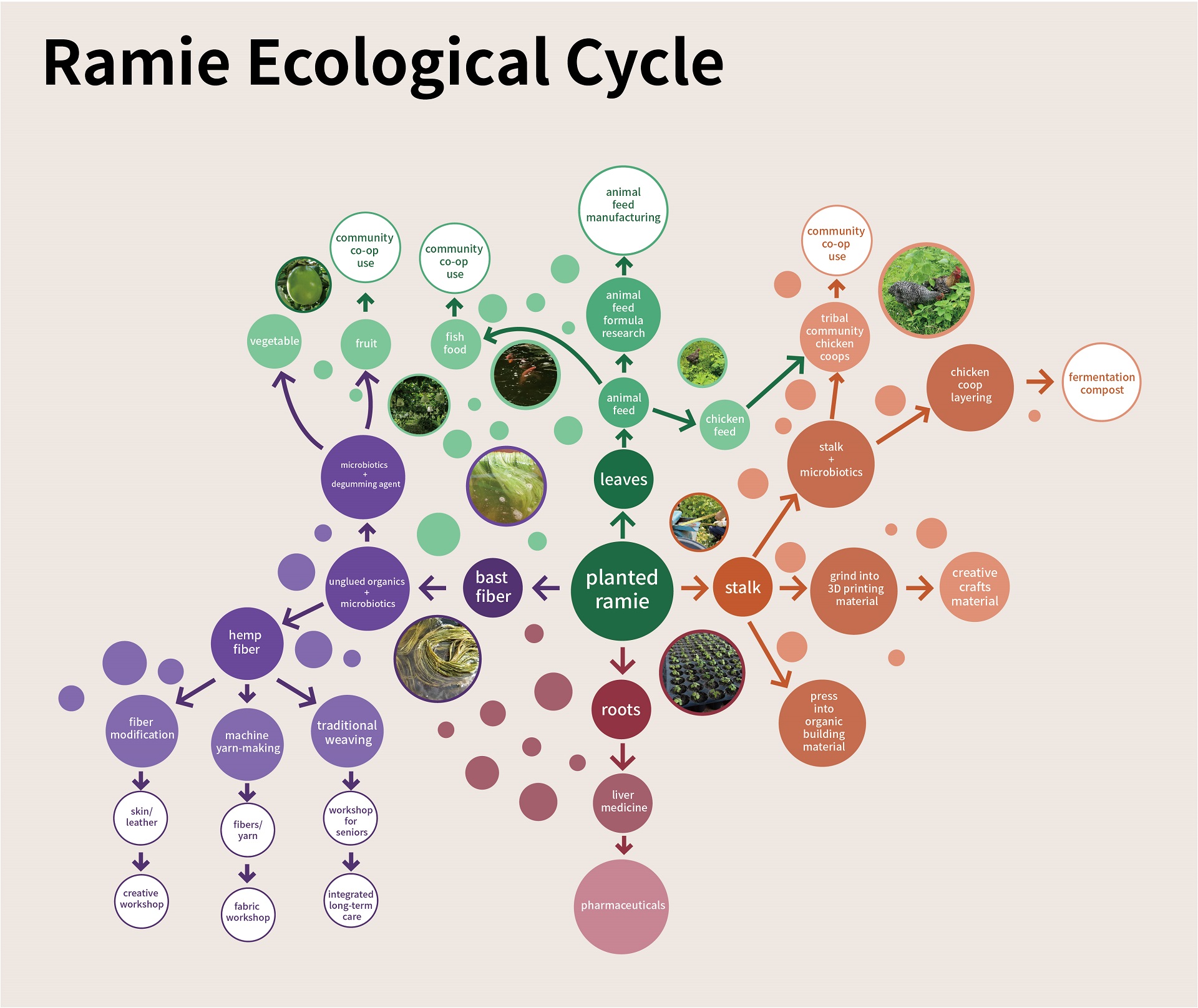date of issue:2021-02-26

Model for Ramie Whole Plant Cycle Uses and Research
Historical records, and the memories of Taiwan’s ancestors passed down to the current generations, have gifted us a new understanding of the ramie plant’s role in Taiwan’s material history. Possessing such a link to the past, ramie now plays an important role in Taiwan’s current indigenous culture Renaissance. It is both a useful material and a powerful symbol. Lihang Studio is currently promoting an innovative model and concept for use of the ramie plant’s entire life cycle for a variety of purposes.
For centuries, ramie was an important material in Taiwan’s indigenous societies, used primarily for weaving. It was, and still is, part of Taiwan’s indigenous culture. Now, with modern information-collecting tools, and data from research on potential new uses for ramie, we can improve and systematize every step of the ramie cultivation process and bring about a new golden age of ramie production.

1、Traditional Ramie Planting
(1)Selecting a strain
After systematic surveying, experimentation, and understanding of the special characteristics of different ramie strains, a strain can be chosen that best suits the needs of Atayal weaving. Traditionally, ramie was divided into three kinds: “Atayal ramie”, “Han ramie”, and “wild ramie”. This was the old concept. Wild ramie stalks are easily cut, but there are too few fibers inside, so therefore it is not useful. Han ramie, or “green heart ramie”, produces many clean fibers, but the stalk is difficult to cleave, which is seen as a weakness. Atayal ramie, or “red heart strain”, appears red from the stalk to the branch network when ripe; it doesn’t produce quite as many fibers as Han ramie, but the fibers are tough, there aren’t too many hairs, and the stalk is easy to cleave.
(2)Cultivating seedlings
Ramie seeds are small, and the seedbed selection has a big influence on growth. It is important to choose an environment with good sun exposure, protection from wind, good irrigation and drainage system, and not too many weeds. The soil should be loose and rich, and there should be equipment to block wind and prevent damage from flying debris. The ramie seedlings and shoots are very delicate, and not very capable of withstanding unsuitable environments, so careful preparation of the soil is crucial.
(3)Transplanting
After ramie became a staple fiber source, over the years cultivating ramie and extracting the fibers, the Atayal people gradually accumulated a set of knowledge on the planting and transplanting process. Traditionally, seeds were planted on virgin soil, or on the edges of burned land. Ramie growing typically involves cutting rhizomes and transplanting. The ideal time for this process is when the air is warm. In Hsinchu and Miaoli, the most suitable time is usually after February
2、Ramie Production/Industry Cycle
Building on past ramie growing experience, a comprehensive plan was begun in 2014 for a whole-plant cultural and economic model of ramie production and industry, beginning on the lands of the indigenous people who originally grew ramie, and with production of material for fabric. A number of new industries are derived from the whole-plant life cycle. These serve the lifestyle and rural ecology of indigenous communities, and include chicken farming, fish farming, and tea growing. These industries affirm traditional culture, and have strong potential for economic growth. Weaving the special ramie cycle into indigenous people’s overall organic agriculture sector, we seek to expand on the traditional use of the plant for clothing and accessories, and bring ramie into the modern world in a sustainable way with regard to land use, energy consumption, and respect for the indigenous cultures that gave birth to the industry.
(1)Merging tradition and technology
Linking ramie whole-plant use and modern scientific knowledge: the leaves, stalks, roots, and stems of ramie plants can be integrated with locally-produced micro biotic and extraction technology.
a.Seek local cultivation of micro biotic, and develop biotechnology skill and knowledge.
b.Ramie root extract for liver-protection medicine.
c.Research biological degumming of ramie.
(2)Integrate economic/production cycle with the local indigenous community: development should be small-scale and beautiful, and contribute to the wider societal and ecological system.
(3)Eco-friendly relationships: ramie is useful for soil and water conservation, for stabilizing sand/dirt, and for dust-proofing. Utilize the carbon sequestration properties of ramie fields for overall environmental protection and regeneration.
(4)Environmentally friendly manufacturing: take advantage of ramie whole-plant life cycle’s recyclable qualities, and implement the principles of natural agriculture. Stick to organic production practices, don’t use industrial pesticides, and set up a standard operating procedure for eco-friendly practices to use and harmful practices to avoid.
(5)Establish a system for use of the whole-plant ramie life cycle
After setting up ramie production in the community, develop a network of both traditional and innovative uses for various parts of the plant.
a. Extract the fibers from the plant, process into yarn for use making clothing accessories and as material for fabric.
b. After fibers are decomposed by micro biotic, use the resulting soaking liquid for fruit irrigation and fish farming.
c. Grind the stalk into a powder, and use as floor spread for chicken coops. After late fermentation, use the high-protein product as fertilizer for growing ramie and hemp. Mix the stalk powder with corn starch, to be used as 3D printing material.
d. Dried ramie leaves can be processed into animal feed.
e. After they have been in the ground for 4 years, the ramie roots can be processed into an ingredient for traditional medicine.
